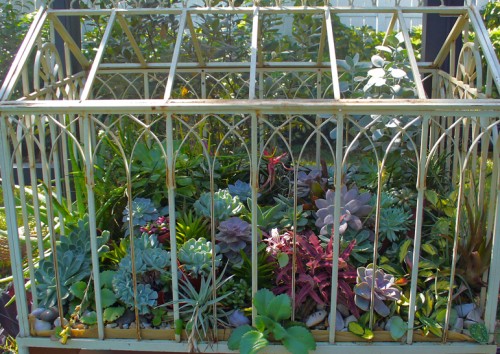 Plants have been growing under glass since the early 1800s, but the real revolution came when Wardian cases made it possible to transport indigenous agricultural goods. Previously, most plants perished onboard ships. Over half of the orchids transported to Europe in the 19th century died in transit.
Plants have been growing under glass since the early 1800s, but the real revolution came when Wardian cases made it possible to transport indigenous agricultural goods. Previously, most plants perished onboard ships. Over half of the orchids transported to Europe in the 19th century died in transit.
Wardian cases were featured in stylish drawing rooms in Western Europe and the United States. The small cases spurred on the fern and orchid crazes, in reaction to the polluted air of Victorian cities. The Victorian terrarium fad is generally credited to writings by Dr. Nathaniel Bagshaw Ward, who published the book called “On the Growth of Plants in Closely Glazed Cases” in 1842.
| Remarkably, this small glass case ushered in a systemic change in commercial agriculture. Encased in glass, plants thrived with almost no help from the outside world. Plantations sprung up after important commercial plants were smuggled in Wardian cases. 20,000 tea plants were exported illegally out of Shanghai, China and as well as the seedlings of the rubber tree of Brazil,leading to the breakup of agricultural monopolies. |
 As gardeners are pinning to get back into their gardens after a long cold winter (yes, even in Florida), some are finding a way to commune with flora— under glass! The CBS Sunday Morning Show featured a number of terrarium enthusiasts in their story “The Growing Trend of Terrariums.” The segment features appearances by Tovah Martin, Paula Hayes and Terrain Store.
As gardeners are pinning to get back into their gardens after a long cold winter (yes, even in Florida), some are finding a way to commune with flora— under glass! The CBS Sunday Morning Show featured a number of terrarium enthusiasts in their story “The Growing Trend of Terrariums.” The segment features appearances by Tovah Martin, Paula Hayes and Terrain Store.
Tovah Martin is one of this country’s best-known garden writers and lecturers. In her book “The New Terrarium”, she writes about the whimsical yet practical world of gardens under glass—a no-fuss way to bring snippets of nature indoors.
Brooklyn based artist and landscape designer Paula Hayes makes exquisitely elegant and expensive terrariums that defy hobby. Paula is an artist whose mediums merge both plants and glass. She combines sculpture and gardening in hand-blown spherical objects using organic shapes. She supported herself as a gardener during her college years and evolved into a master sculpture. Starting in the early 1990s Paula fused sculpture with her love of gardening in New York City’s East Village.
Hayes’ living sculptures take the form of terrariums and beyond. On her website in addition to her terrariums you will see bird feeders, necklaces and planters. Her exhibition, “Nocturne of the Limax Maximus,” is showing at the Museum of Modern Art in New York from November 17, 2010–April 18, 2011.
Links

[…] To find out more about Wardian Cases see our post with more info […]